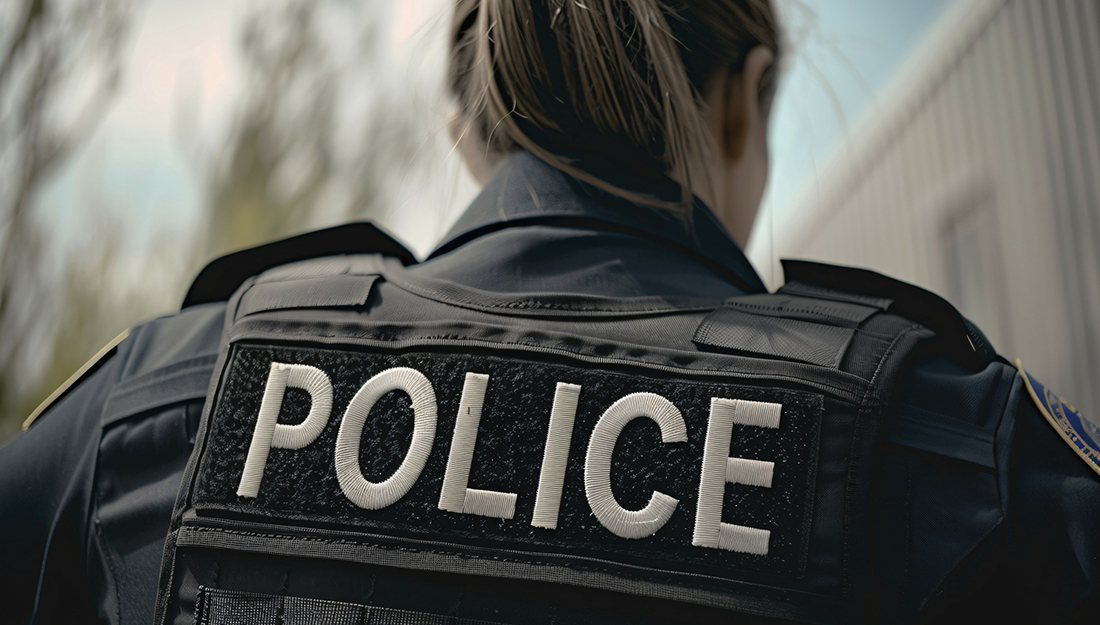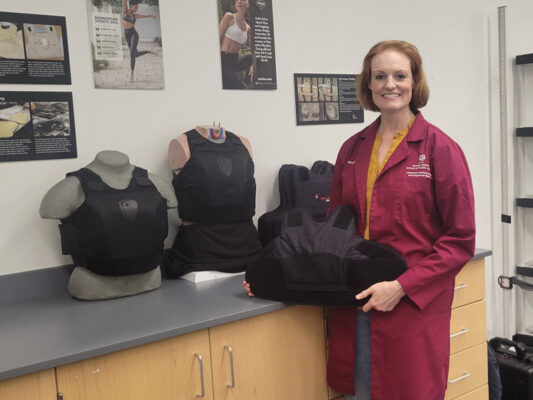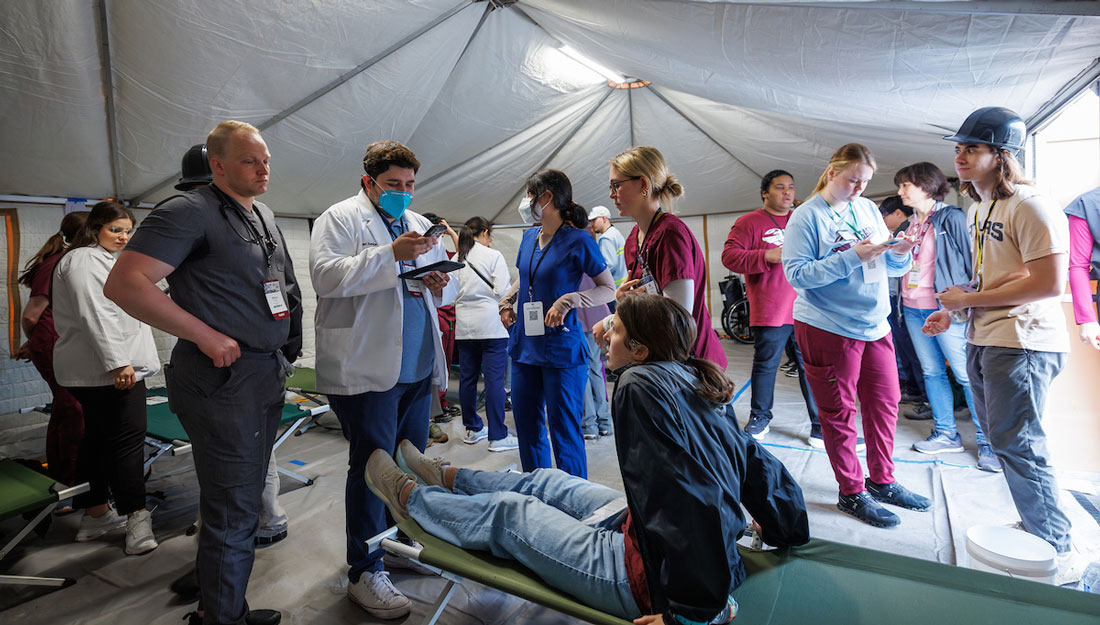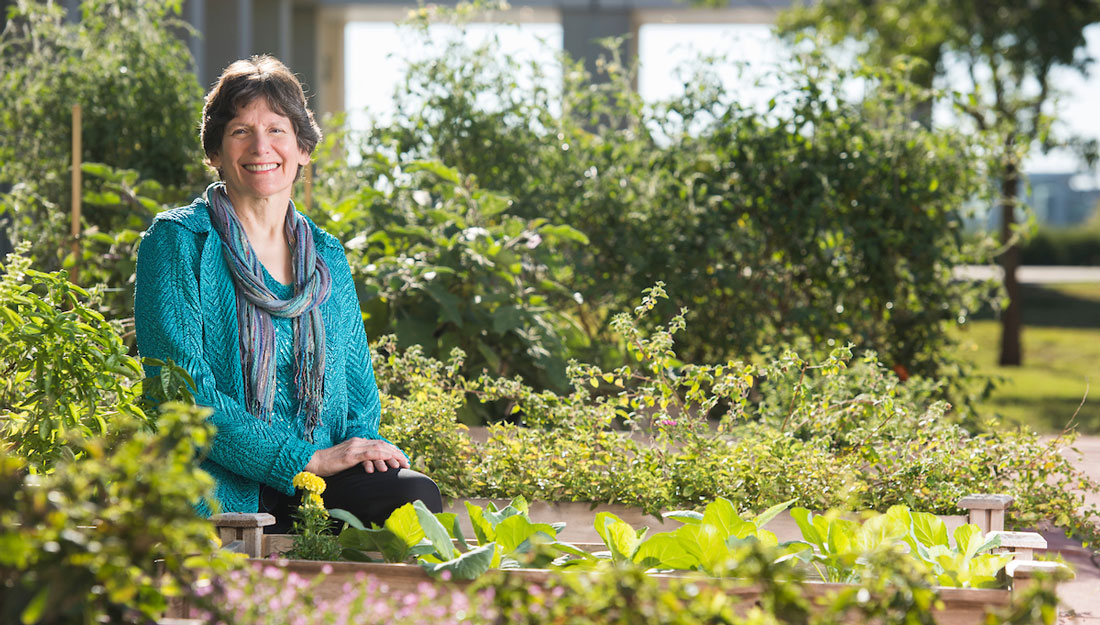- Rae Lynn Mitchell
- Community Impact, Homepage Featured, Public Health, Research, Show on VR homepage
Bras, breasts and bulletproof vests
One PhD student’s mission to protect women in uniform

Back view of female police officer with bulletproof vest with text 'Police'.
What do bra fitting and body armor testing have in common? Andrea Porter’s dissertation. When Porter took a sabbatical from her career to earn her PhD in multidisciplinary engineering, she never imagined she would become a professional bra fitter, much less out on the shooting range, testing body armor. But her ergonomics research took her to both—optimizing armor comfort and investigating armor protection for women.
Porter’s research advisor, Mark Benden, PhD, department head for Environmental and Occupational Health at the Texas A&M University School of Public Health and a multidisciplinary engineering professor, quickly saw the significance of her work. Benden, who also directs the school’s Center for Worker Health where Porter works as a graduate research assistant, helped secure funding and resources to support her research.
A pattern of poor fit

Porter’s journey into this field began long before she stepped onto the range. While living in Amarillo, Texas, Porter mentored teenaged girls at the high school where her husband taught. Several of her mentees joined the military and one entered law enforcement after graduation. Porter kept in touch with them and was surprised to hear a consistent thread in the girls’ experiences.
“They each shared that their body armor made tasks difficult and caused extreme discomfort and pain,” Porter said. “Until then, I had assumed that armor was optimized by gender.”
One soldier described how her armor’s long torso caused it to ride up when she hit the ground, tipping her helmet forward and obstructing her vision. A police officer showed Porter scars under her chin from armor that had rubbed her skin raw during patrols. Running presented its own challenges—women had to either hold their vests in place, slowing them down, or tighten them so much that it restricted breathing.
“Women face a no-win situation: They can either hold the vest with at least one arm while running, which slows their speed, or tighten it around the armor around their torso, which restricts breathing,” Porter said. “Neither is a good choice.”
Porter recognized that while she lacks the courage to serve in these roles, she could contribute by improving the tools these professionals rely on.
“Professionals across work sectors must understand how to optimize environment-necessary equipment and tools for different types of human bodies,” Benden said.
He also understood the inherent problems of traditional body armor due to his eight years’ experience serving in the Texas Army National Guard and United States Army Reserve.
“Andrea’s research will make great strides in balancing the fit and comfort of body armor for women and strengthen the protection those devices are supposed to provide,” he said.
From ergonomics to bra fitting
Porter has been interested in ergonomics—the science of optimizing equipment and environments to better fit workers—since working at a retirement home. However, she hadn’t expected her work to intersect with body armor until she connected with Benden, who encouraged her to take on the project. What started as a broad study of women’s armor design quickly zeroed in on a surprising factor: the bra.
“A female officer’s bra choice affects how her armor fits, how comfortable she is, and even how effectively she can move,” Porter said. “A bad bra fit can mean bad armor fit.”
In a survey of almost 1,000 female law enforcement officers, Porter found that the type of bra they wore under their armor significantly influenced comfort and mobility. Surprisingly, officers who didn’t wear bras often reported feeling more comfortable in their armor across various activities.
“These numbers told us something important: Armor isn’t just a sizing issue—it’s an interaction issue,” Porter explains. “What’s underneath the armor, like a poorly fit bra, and how much equipment is attached to the outside of the armor, greatly affects a female officer’s comfort.”
Another challenge is that most armor fitters are male, making discussions about the bra and body armor interaction awkward.
“It can be a difficult conversation for both sides, so I’m working on guidance to help both male armor fitters and female law enforcement officers navigate these fitting issues,” Porter said.
Taking research to the shooting range
Another key aspect of Porter’s research involved how air gaps between the armor and the body affect protection. This investigation introduced her to a new place—the shooting range.
“I grew up in a family where guns were a ‘man thing,’ so I never went with them, nor was I interested in shooting,” she said. “Suddenly, I was standing on a range with some guys teaching me about different guns, calibers, gun power and how to shoot. I certainly did not plan to learn that in my PhD.”
With support from Survival Armor, a woman-run body armor company in Florida, Porter conducted testing in their lab on a clay dummy wearing silicone breasts, a bra and soft armor. She also tested the effect of the shots to the dummy using different breast sizes, which changed the depth of the gaps between the armor and the dummy under the cup.
The results were unexpected. The larger the air gap created by the breasts, the more protective the vests were.
“We found shots to the areas with gaps between the body and the armor experienced less harm than a shot to an area where the armor was in direct contact,” Porter said. “This benefit may also extend to male law enforcement officers who have gaps in their armor fit.”
Current armor certification tests armor in complete contact with a clay block, which doesn’t account for how it actually fits a person—especially a woman. These findings add to the body of knowledge about armor performance in the field.
Shaping the future of body armor for women
Porter’s research is already gaining attention from law enforcement agencies across the country. By identifying how factors like bra fit, breast size and armor gaps influence performance, she hopes to educate officers on optimizing their armor fit and comfort.
“This research recognizes that women’s armor fit, and comfort, requires a broader scope than just the armor itself, which has been the focus in the past,” she said.
For Porter, this research has been both challenging and rewarding.
“The hardest part has been the bra aspect,” she said. “It’s a loaded topic because breasts are sexualized and joked about, and there are biases to navigate. My priority has been to maintain the dignity of this topic.”
At one point, she considered shifting her focus away from bras entirely, but Benden encouraged her to stay the course.
“He told me, ‘This is science. Sometimes you learn things you didn’t expect or want to deal with, but you have to keep going to add to the body of knowledge so things can improve. Science is science.’ That perspective has helped me stay focused on the bigger picture and been my most valuable lesson in this PhD journey,” Porter said.
____________________________________________
Why this matters:
- Women make up 12% of law enforcement, but a federal initiative is working to increase the percentage to 30% by 2030.
- In a survey of nearly 1,000 female law enforcement officers, 75% of them reported breast pain while wearing their armor.
Media contact: media@tamu.edu


